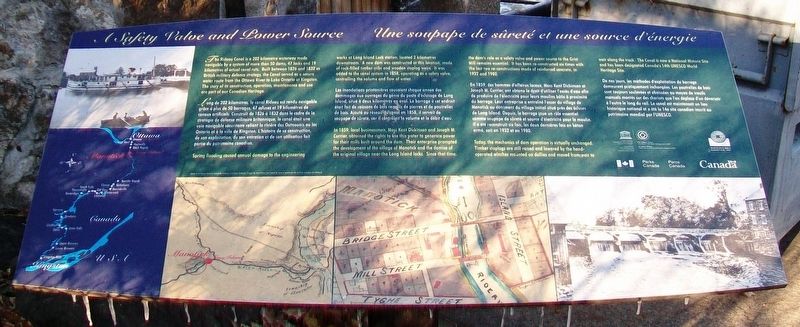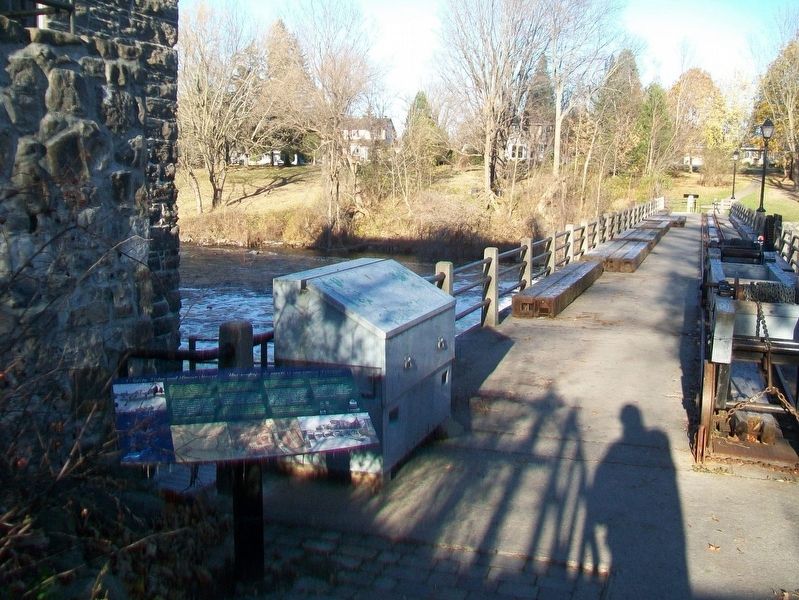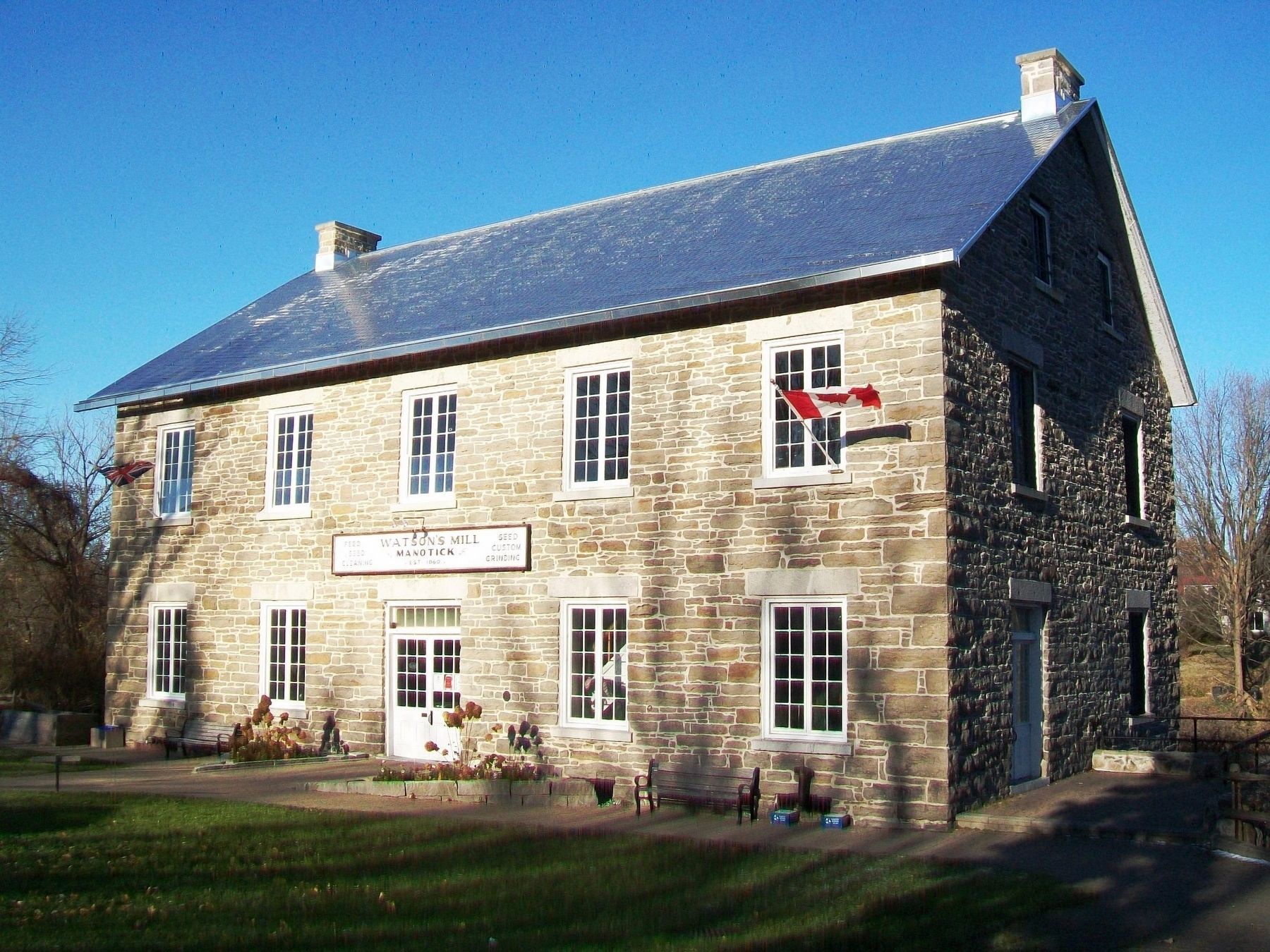Manotick in Ottawa, Ontario — Central Canada (North America)
A Safety Valve and Power Source
Une soupape de sûreté et une source d'énergie
Spring flooding caused annual damage to the engineering works at Long Island Lock station, located 2 kilometres downstream. A new dam was constructed at this location, made of rock-filled timber cribs and wooden stoplog weirs. It was added to the canal system in 1858, operating as a safety valve, controlling the volume and flow of water.
In 1859, local businessmen, Moss Kent Dickinson and Joseph M. Currier, obtained the rights to use this water to generate power for their mills built around the dam. Their enterprise prompted the development of the village of Manotick and the demise of the original village near the Long Island locks. Since that time, the dam's role as a safety valve and power source to the Grist Mill remains essential. It has been re-constructed six times with the last two re-constructions made of reinforced concrete, in 1932 and 1980.
Today, the mechanics of dam operation is virtually unchanged. Timber stoplogs are still raised and lowered by the hand-operated winches mounted on dollies and moved from weir to weir along the track. The Canal is now a National Historic Site and has been designated Canada's 14th UNESCO World Heritage Site.
——————————————————
Les inondations printanières causaient chaque années des dommages aux ouvrages du génie du poste d'éclusage de Long Island, situé à deux kilomètres en aval. Le barrage à cet endroit était fait de caissons de bois remolis de pierres et de poutrelles de bois. Ajouté au réseau du canal en 1858, il servait de soupape de sûreté, car il contrôlait le volume et le débit d'eau.
En 1859, des hommes d'affaires locaux,
Moss Kent Dickinson et Joseph M. Currier, ont obtenu le droit d'utiliser l'excès d'eau afin de produire de l'électricité pour leurs moulins bâtis à proximité du barrage. Leur entreprise a entraîné l'essor du village de Manotick au détriment du village initial situé près des écluses de Long Island. Depuis, le barrage joue un rôle essentiel comme soupape de sûreté et source d'électricité pour le moulin. Il a été reconstruit six fois, les deux dernières fois en béton armé, soit en 1932 et en 1980.
De nos jours, les méthodes d'exploitation du barrage demeurent pratiquement inchangées. Les poutrelles de bois sont toujours soulevées et abaissées au moyen de treuils manuels montés sur des chariots que l'on déplace d'un déversoir à l'autre le long du rail. Le canal est maintenant un lieu historique national et a été le 14e site canadien inscrit au patrimoine mondial par l'UNESCO.
Sketch of the Rideau Canal by Colonel By / Croquis du canal Rideau par Colonel By
Erected by Watson's Mill Manotick, Inc., Parks Canada, and UNESCO.
Topics. This historical marker is listed in these topic lists: Industry & Commerce • Man-Made Features • Settlements & Settlers • Waterways & Vessels. A significant historical year for this entry is 1826.
Location.
45° 13.614′ N, 75° 40.96′ W. Marker is in Ottawa, Ontario. It is in Manotick. Marker is on Dickinson Street just north of Mill Street, on the right when traveling north. Touch for map. Marker is at or near this postal address: 5525 Dickinson Street, Ottawa ON K4M 1A2, Canada. Touch for directions.
Other nearby markers. At least 8 other markers are within walking distance of this marker. The Mill and Manotick / Le moulin et Manotick (here, next to this marker); The Long Island Mill (within shouting distance of this marker); Carriage Shed / Hangar à chariots (within shouting distance of this marker); Dickinson Square and Manotick / La Place Dickinson et Manotick (within shouting distance of this marker); Dickinson House / Maison Dickinson (within shouting distance of this marker); A Square for All Time / Un place en permanence (within shouting distance of this marker); Family Life / la vie familiale (within shouting distance of this marker); The Perpetual Challenge / Le defi perpétuel (within shouting distance of this marker). Touch for a list and map of all markers in Ottawa.
Also see . . .
1. Watson's Mill History. (Submitted on January 6, 2018, by William Fischer, Jr. of Scranton, Pennsylvania.)
2. Watson's Mill, Manotick on YouTube. (Submitted on January 6, 2018, by William Fischer, Jr. of Scranton, Pennsylvania.)
3. Rideau Canal National Historic Site. (Submitted on January 6, 2018, by William Fischer, Jr. of Scranton, Pennsylvania.)
4. History of the Rideau Canal. (Submitted on January 6, 2018, by William Fischer, Jr. of Scranton, Pennsylvania.)
Credits. This page was last revised on January 24, 2022. It was originally submitted on January 6, 2018, by William Fischer, Jr. of Scranton, Pennsylvania. This page has been viewed 216 times since then and 7 times this year. Photos: 1, 2. submitted on January 6, 2018, by William Fischer, Jr. of Scranton, Pennsylvania. 3. submitted on November 20, 2017, by William Fischer, Jr. of Scranton, Pennsylvania.


